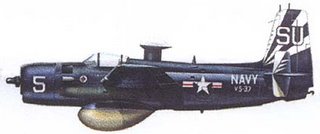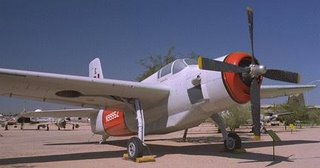Flightdeck Friday!

 required. Three manufacturers, Douglas, Martin and Grumman eventually provided viable candidates for this requirement. Grumman’s offerings were the G-55, a twin engine aircraft based on the F7F and which would later be designated XTB2F-1, but subsequently cancelled a few months later in favor of the G-70.
required. Three manufacturers, Douglas, Martin and Grumman eventually provided viable candidates for this requirement. Grumman’s offerings were the G-55, a twin engine aircraft based on the F7F and which would later be designated XTB2F-1, but subsequently cancelled a few months later in favor of the G-70.  The G-70, later designated the XTB3F-1, was a “composite” powered aircraft, with a single 2,300 hp R-2800-46 radial engine and a Westinghouse 19XB jet on the tail to provide an extra burst of speed for launch and approaching the target. Unlike the Avenger, it did not have self defense armament, relying instead on speed. It held a crew of two, sitting side-by-side and a torpedo bay that could accommodate two torpedoes. The Navy was sufficiently impressed that it went ahead and ordered two prototypes.
The G-70, later designated the XTB3F-1, was a “composite” powered aircraft, with a single 2,300 hp R-2800-46 radial engine and a Westinghouse 19XB jet on the tail to provide an extra burst of speed for launch and approaching the target. Unlike the Avenger, it did not have self defense armament, relying instead on speed. It held a crew of two, sitting side-by-side and a torpedo bay that could accommodate two torpedoes. The Navy was sufficiently impressed that it went ahead and ordered two prototypes. flew in December 1945. Subsequent flight tests determined that the jet assist did not live up to its billing and it was subsequently removed, providing space for additional internal carrying capacity. With that additional carrying capability and mindful of the submarine threat, Grumman re-designed the XTB3F-1 (now the XTB3F-1S) with the addition of the APS-20 radar, developed from Project Cadillac and previously installed on the TBM-3W series. The Avenger, large as it was, was space and performance challenged with the APS-20 installation. The XTB3F-1S with its larger powerplant and carrying capacity addressed these issues.
flew in December 1945. Subsequent flight tests determined that the jet assist did not live up to its billing and it was subsequently removed, providing space for additional internal carrying capacity. With that additional carrying capability and mindful of the submarine threat, Grumman re-designed the XTB3F-1 (now the XTB3F-1S) with the addition of the APS-20 radar, developed from Project Cadillac and previously installed on the TBM-3W series. The Avenger, large as it was, was space and performance challenged with the APS-20 installation. The XTB3F-1S with its larger powerplant and carrying capacity addressed these issues. Sufficiently impressed, the Navy ordered two variants – the APS-20 equipped AF-2W and the AF-2S with a wing mounted APS-30. These aircraft would be powered by the 2,400 hp R-2800-48W. The AF-2W would also carry two additional crew to operate the APS-20. The  concept here is that the aircraft would operate paired as “Hunter-Killers” – the AF-2W with its long range search radar would sweep the ocean’s surface for surfaced or snorkeling submarines and once detected, direct the AF-2S into the target vicinity. Taking over the attack, the AF-2S would use its APS-30, with its shorter-ranged but higher resolution radar to identify the target (along with a wing mounted searchlight) and attack the target with depth charges, bombs, torpedoes or rockets. This practice was already in effect with similar versions of the Avenger – the TBM-3W and the TBM-3S.
concept here is that the aircraft would operate paired as “Hunter-Killers” – the AF-2W with its long range search radar would sweep the ocean’s surface for surfaced or snorkeling submarines and once detected, direct the AF-2S into the target vicinity. Taking over the attack, the AF-2S would use its APS-30, with its shorter-ranged but higher resolution radar to identify the target (along with a wing mounted searchlight) and attack the target with depth charges, bombs, torpedoes or rockets. This practice was already in effect with similar versions of the Avenger – the TBM-3W and the TBM-3S.
 The Guardian was a large aircraft – in fact, the largest single engine carrier-based aircraft flown by the Navy. With a wingspan of 60 feet 8 inches and standing 16 feet 2 inches off the ground (due to the size of the required prop), and fully loaded (the plane could weigh as much as 25,500 pounds for the AF-2S and 22,500 pounds for the AF-2W), the Guardian could be challenging operating off the Essex-class CVs. It was while operating off the
The Guardian was a large aircraft – in fact, the largest single engine carrier-based aircraft flown by the Navy. With a wingspan of 60 feet 8 inches and standing 16 feet 2 inches off the ground (due to the size of the required prop), and fully loaded (the plane could weigh as much as 25,500 pounds for the AF-2S and 22,500 pounds for the AF-2W), the Guardian could be challenging operating off the Essex-class CVs. It was while operating off the
The last of the AF-2s were retired 31 Aug 1955. Some models of the AF-2S were subsequently modified for use as fire “bombers” but were short-lived in this endeavor due to concerns over single engine performance/ reliability and load carrying compared to the availability of ex-WWII multi-engine bombers. Today, examples of the AF-2S may be found at the National Museum of Naval Aviation in
modified for use as fire “bombers” but were short-lived in this endeavor due to concerns over single engine performance/ reliability and load carrying compared to the availability of ex-WWII multi-engine bombers. Today, examples of the AF-2S may be found at the National Museum of Naval Aviation in
the AF-2W left.
 (Testimony to Grumman's legendary toughness, an AF-2S is towed off the field at Fentress OLF after a wheels up landing)
(Testimony to Grumman's legendary toughness, an AF-2S is towed off the field at Fentress OLF after a wheels up landing)
General characteristics
* Crew: 3-4
* Length: 43 ft 4 in
* Wingspan: 60 ft 8 in
* Height: 16 ft 2 in
* Wing area: 560 ft²
* Empty weight: 14,580 lb
* Max takeoff weight: 25,500 lb
* Powerplant: 1× Pratt & Whitney R-2800-48W "Double Wasp" radial engine, 2,400 hp
Performance
* Maximum speed: 274 knots
* Range: 1,304 nm
* Service ceiling: 32,500 ft
* Rate of climb: 1,850 ft/min










|